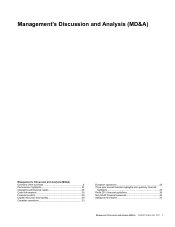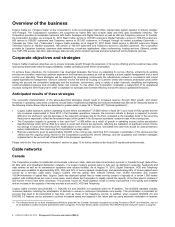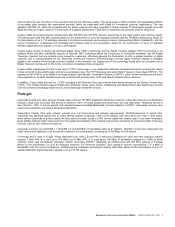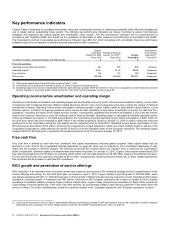Cogeco 2010 Annual Report Download - page 18
Download and view the complete annual report
Please find page 18 of the 2010 Cogeco annual report below. You can navigate through the pages in the report by either clicking on the pages listed below, or by using the keyword search tool below to find specific information within the annual report.Management’s Discussion and Analysis (MD&A) COGECO CABLE INC. 2010 17
Multiple deliverable revenue arrangements
In December 2009, the EIC issued a new abstract concerning multiple deliverable revenue arrangements, EIC-175, Multiple deliverable
revenue arrangements, which amended EIC-142, Revenue arrangements with multiple deliverables. EIC-175 requires a vendor to allocate
arrangement consideration at the inception of the arrangement to all deliverables using the relative selling price method, thereby eliminating the
use of the residual value method. The amendment also changes the level of evidence of the standalone selling price required to separate
deliverables when more objective evidence of the selling price is not available. EIC-175 should be adopted prospectively to revenue
arrangements entered into or materially modified in the first annual fiscal period beginning on or after January 1, 2011, with early adoption
permitted. The Corporation is currently evaluating the option to early-adopt this EIC in fiscal 2011.
Controls and procedures
The President and Chief Executive Officer (“CEO”) and the Senior Vice President and Chief Financial Officer (“CFO”), together with
management, are responsible for establishing and maintaining adequate disclosure controls and procedures and internal controls over financial
reporting, as defined in National Instrument 52-109. Cogeco Cable’s internal control framework is based on the criteria published in the report
“Internal Control-Integrated Framework” issued by the Committee of Sponsoring Organizations of the Treadway Commission and is designed to
provide reasonable assurance regarding the reliability of financial reporting and the preparation of financial statements for external purposes in
accordance with Canadian GAAP.
The CEO and CFO, supported by management, evaluated the design and operation of the Corporation’s disclosure controls and procedures
and internal controls over financial reporting as of August 31, 2010, and have concluded that they are effective. Furthermore, no significant
changes to the internal controls over financial reporting occurred during the year ended August 31, 2010.
Uncertainties and main risk factors
This section outlines general as well as more specific risks faced by Cogeco Cable and its subsidiaries that could significantly affect the
financial condition, operating results or business of the Corporation. It does not purport to cover all contingencies, or to describe all possible
factors that might have an influence on the Corporation or its activities at any point in time. Furthermore, the risks and uncertainties outlined in
this section may or may not materialize in the end, may evolve differently than expected or may have different consequences than those that
are being presently anticipated.
Cogeco Cable applies an on-going risk management process that includes a quarterly assessment of risks for the Corporation and its
subsidiaries, under the oversight of the Audit committee. As part of this process, the Corporation endeavours to identify risks that are liable to
have a major impact on the Corporation’s financial situation, revenue or activities, and to mitigate such risks proactively as may be reasonable
and appropriate in the circumstances. This section reflects management’s current views on uncertainties and the main risk factors.
Risks pertaining to markets and competition
Electronic communications markets continue to evolve rapidly and are very competitive in both Canada and Portugal. Competitors offer video
distribution, broadband HSI access, fixed telephone, mobile telephone and fixed and mobile data services through various means of
telecommunications facilities, including terrestrial wireline and wireless networks as well as satellite. Rivalry extends over several elements
comprising the value proposition, including the features of individual services, the composition of service bundles, the range of content or
service options, quality of service, speed of delivery, regular introductory and promotional pricing or offers, duration of the commitment by the
customer, terminal devices and customer service. Service bundles offered by competitors include up to “quadruple-play” offers combining
television, HSI, fixed and mobile telecommunications to residential and commercial customers.
Cogeco Cable provides “double-play” and “triple-play” service bundles both in Canada and in Portugal, with various combinations of Telephony,
HSI and Television distribution services being offered at attractive bundle prices, but does not offer “quadruple-play” service bundles that
include mobile communications. Cogeco Cable does not offer mobile Internet service. The Corporation continues to focus on its existing lines of
service with a view to capturing the remaining growth opportunities for HSI, Digital Television and Telephony services in its footprint, making
the most efficient use of its own hybrid fibre-coaxial (“HFC”) plant. As markets evolve and mobility becomes a more cost-effective substitute to
wireline communications, Cogeco Cable may need to add mobility components to its service offerings, through suitable mobile virtual network
(“MVNO”) arrangements with existing or future mobile operators, or otherwise through new wireless alternatives. There is no assurance that
appropriate MVNO arrangements will be concluded by the Corporation when needed, and their impact on the financial results cannot be
assessed at this time. Also, the capital and operating expenditures eventually required to offer quadruple-play service bundles and mobile
services may not be offset by the incremental revenue that such new bundles or mobile services would generate, thus resulting in downward
pressure on operating margins.
In Canada, Cogeco Cable currently faces competition in its service areas mainly from a few large integrated telecommunications service
providers. The largest, Bell Canada (“Bell”), offers through its various operating entities a full range of competitive voice, data and video
services to residential, as well as to business customers in the Provinces of Québec and Ontario through a combination of fixed wireline, mobile
terrestrial wireless and satellite platforms. Bell has commenced the rollout of Internet Protocol Television (“IPTV”) services over its fixed wireline
platform and the deployment of optical fibre to residential premises in certain areas within its service footprint. Telus Communications Company
(“Telus”) competes with all of Cogeco Cable’s services in the Lower St. Lawrence area of the Province of Québec through the use of its wireline
network, and throughout Cogeco Cable’s Canadian footprint through the use of its mobile telecommunications network. Telus has also
commenced the deployment of optical fibre to residential premises in certain areas within its service footprint. However, Cogeco Cable’s
Telephony service is provided with the assistance of certain Telus carrier services through a long-term contractual arrangement. Shaw Direct
(formerly Star Choice Television Network Incorporated), an indirect subsidiary of Shaw Communications Inc. (“Shaw”), competes for video and
























